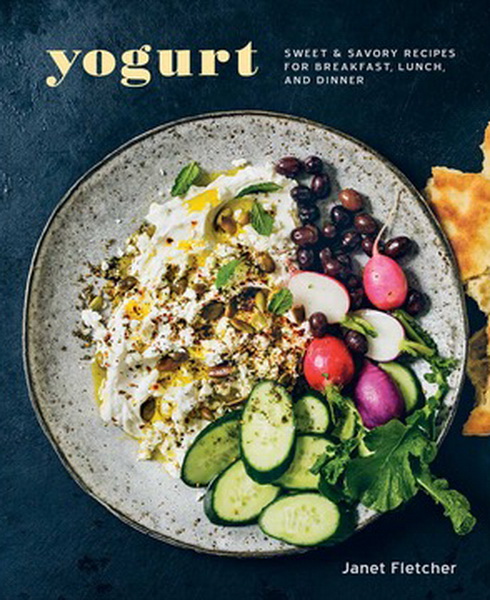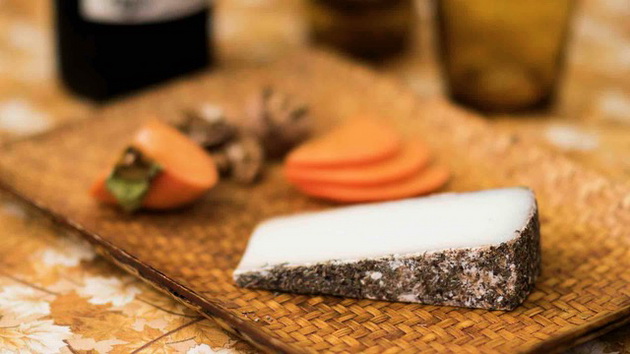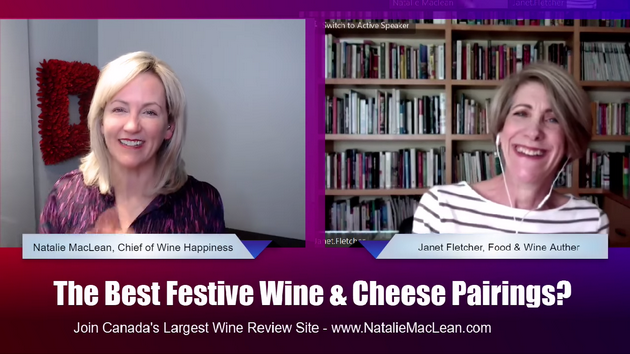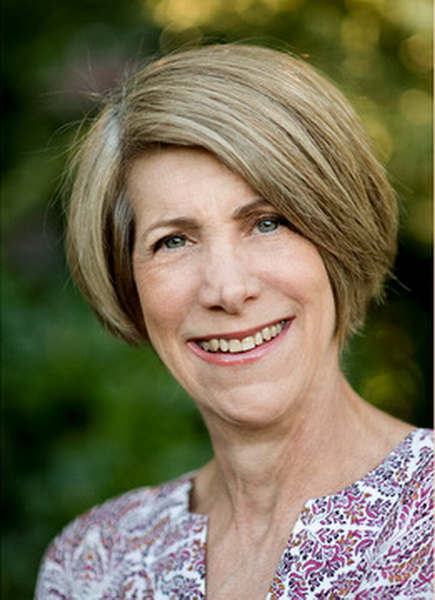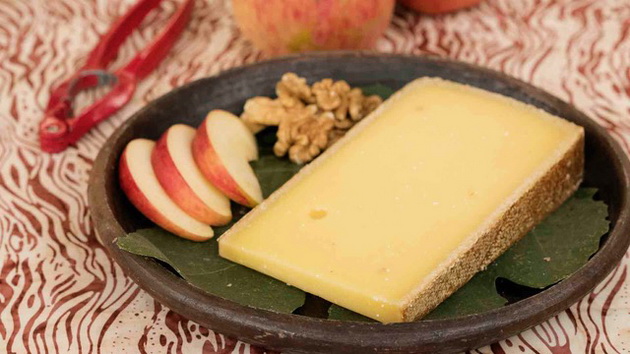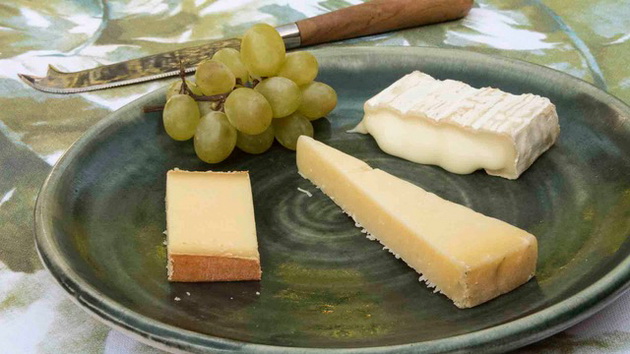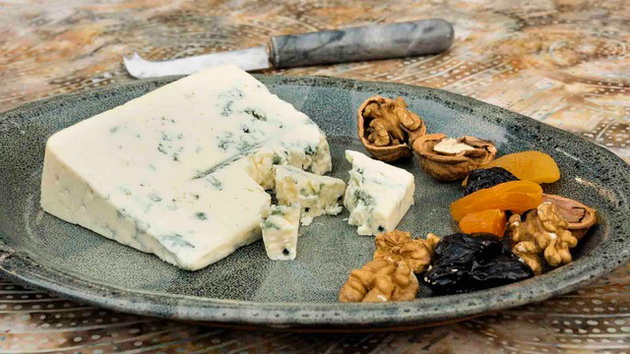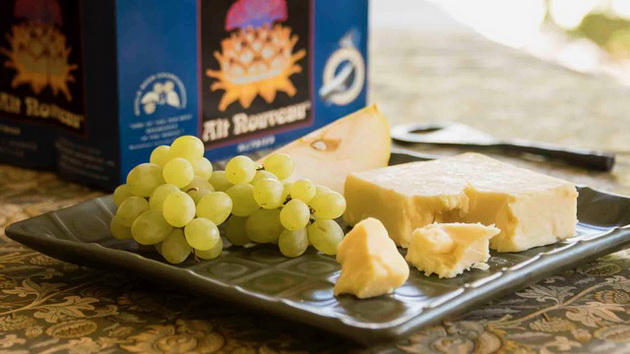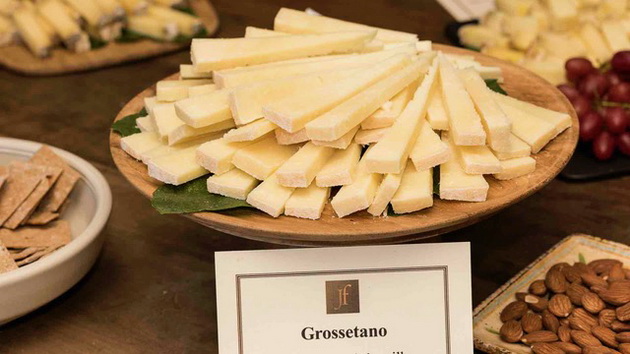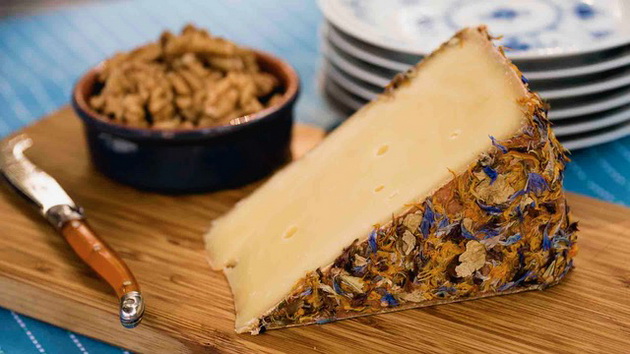Click on the Follow and Like buttons on this page to get notified when we go live.
We’ll be simultaneously broadcasting on Facebook Live, YouTube Live Stream and Twitter Live Video via Periscope.
Watch previous episodes of the Sunday Sipper Club (SSC) and find out who’s coming up next.
If you’d like to read the comments for this tasting, or make a comment yourself, visit:
https://www.facebook.com/natdecants/videos/10155625565449845/
Here’s a sampling of our lively discussion from our Janet Fletcher Video Chat:
Lori Kilmartin51:49 I liked the idea of doing a comparative tasting with the same cheese. Maybe find a good matching wine and do a comparative with them at the same time!!
Lise Charest Gagne32:13 We call cheese rind la croute
Lise Charest Gagne37:54 We had 20 cheese on our board last weekend
Elaine Bruce47:32 I love the warmed goat cheese idea
Sam Hauck22:05 Agree that too few appreciate sherries.
Deborah Podurgiel34:53 Love the Croûte Fleuri particularly on ripe rind cheeses![]() 🙂
🙂
John Clutterbuck54:45 I have a dinner and wine club here in Bicester, UK and soon to start a wine club / circle for people who are interested in wine and all it’s many facets that make wine so interesting. Pity we are not in Canada but great to know we have a common interest. Might get to Canada one day who knows. Like what you are doing.
Robin Anne Bailey1:04 Brie…
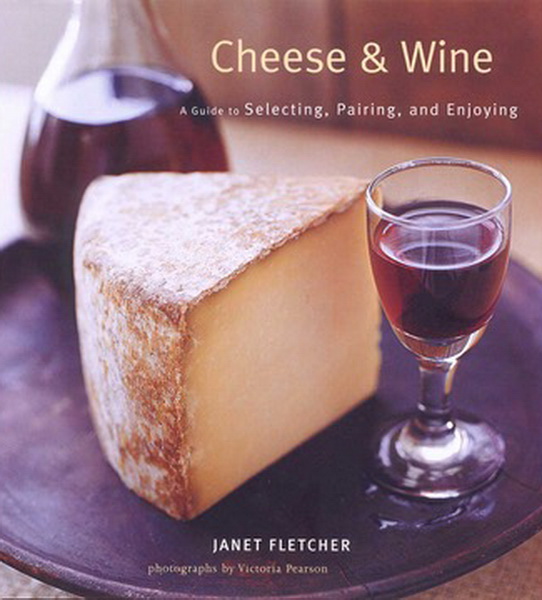 Cheese & Wine by Janet Fletcher
Cheese & Wine by Janet Fletcher
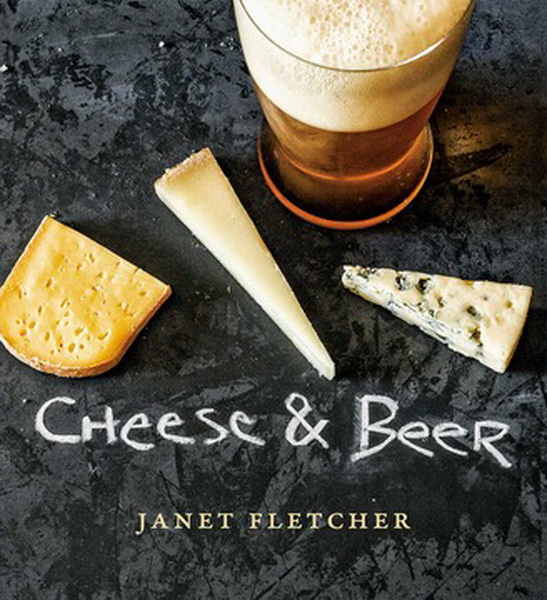 Cheese & Beer by Janet Fletcher
Cheese & Beer by Janet Fletcher
Janet Fletcher is the author or co-author of nearly 30 books on food and beverage, including Cheese & Wine, Cheese & Beer and Yogurt: Sweet and Savory Recipes for Breakfast, Lunch, and Dinner. Janet publishes the weekly Planet Cheese blog and is the cheese columnist for Specialty Food and Somm Journal magazines.
She teaches cooking and cheese-appreciation classes around the country. Her journalism has received three James Beard Awards and the IACP Bert Greene Award, and her food writing has appeared in numerous national publications, including The New York Times, Saveur, Fine Cooking and Food & Wine. (www.janetfletcher.com)
So the holidays are right around the corner, and I think one of the easiest ways to entertain is with wine and cheese. One of the easiest and most delicious. But which wines with which cheeses?
Well, our guest tonight who joins me live from Napa Valley, is going to give us lots of super insider tips and pairings that we can try this holiday.
I’m Natalie MacLean, editor of Canada’s largest wine review site at nataliemclean.com, and you’ve joined us here live on the Sunday Sipper Club where we gather every week at 6 p.m. Eastern, Toronto/New York time, to talk to the most intriguing people in the wine and food world.
Now before I introduce our guest fully, please, in the comments below, just let me know what is your favorite type of cheese. I’ll bet we’ll find a great wine pairing for it tonight. But just post in the, is it brie, is it cheddar, is it blue? Which wine do you absolutely love the most? I’d love to know that.
And I am going to head over to Facebook and make sure that you all are seeing and hearing this and I am not talking to space, an empty vacuum. And then I will bring on excellence. So Ann is here, Beverly is here, all right folks. Michelle, okay, all right.
So our guest this evening has written almost 30 books on the topic of food and beverage and she’s won many awards from James Beard to others for her work. She’s written books like Wine & Cheese. Or sorry, Cheese and Beer as well and many other topics. And she also runs the very popular website/blog Planet Cheese. And she joins me live from her home in Napa Valley now. Welcome to the Sunday Sipper Club, Janet Fletcher.
Thanks Natalie, fun to be with you.
Excellent, perfect. So that was really high-level, my intro. Tell us, fill in some details that I left out, maybe tell us something that would surprise folks about yourself, whatever you wish.
Well, wine and food and cheese and gardening are my life. This is what I do for a living, and it’s what I do for pleasure. So I’ve just had the great good fortune of being able to bridge the things I love most with my profession. And it’s been just a really fun way to make a living for the last 30 years.
I write a lot about produce as well, about farms and farming and sustainable agriculture in recent years, but cheese has become, I would say over the last 15 years, it’s become kind of a subspecialty. And I think I’m more and more known for my cheese classes, my Planet Cheese blog now. I still think of myself as a general food writer, but a lot of people when they hear my name first, they think of cheese.
Excellent, well terrific. And people are just pouring in to our virtual wine bar here, Janet. I’m looking at the comments on Facebook. I’ll feed them to you if you wish. Wow they’re going fast. Shell, am I pronouncing your name correctly? Shell O’Connor, looking forward to tonight’s discussion. Elaine Bruce joins us from Alberta. Beverly Ashland in California, welcome Janet. Leigh, Sharey Garnier. Hello we’re decorating for the holidays, they’re up in Sudbury. Excellent folks. So please post if you have a favorite type of cheese.
So Janet, when did you first realize that you wanted to write about cheese? What was it that drew you to cheese specifically among all the other produce and wine and beer and so on? What was it about cheese?
Well, what really happened is that as a food writer, a cookbook writer, cookbook author, and I’m always on the lookout for the next trend. What’s the next thing people are talking about that I might want to write about, that captures my fancy? And it was maybe 15 or 17 years ago that I started noticing that, in the States, more and more restaurants were serving cheese. For so many years they didn’t. Or if they did serve cheese, it was really a half-hearted effort. Maybe they had a wheel of brie in the fridge and they would bring it out if somebody asked for cheese. And so consequently, nobody ever did ask for cheese and restaurants just didn’t serve it.
But I started to see more and more cheese plates, cheese carts coming into restaurants. And more than that, I started to see that restaurants and chefs were doing interesting things with cheese. They were adding a certain condiment or a special bread or using the cheese creatively in a salad or with a condiment.
So I started to think about the idea of a little book that I called the Cheese Course that helped people put cheese in the context of a course with something that kind of showed it off and merchandize did a little more so that people would want it. So that was my first book about cheese.
It’s still in print and it led to my being asked to write a column for the San Francisco Chronicle where I already was writing food pieces that they said why don’t you do a cheese column? So that ran for about 10 years and I just learned by writing. So it’s really my deep dive in the culture and science and history of cheese and the people behind cheese, which is something I’ve always, as an adult, I’ve always enjoyed, it’s always been part of our table.
Absolutely. And so how did you, going back to that first book, what suggestions did you have in there with pairing cheese with different other foods to make it more of a course, so to speak? What were you suggesting that people do with cheese?
Well I would say these days, I’d probably back off of that a little bit, more than I did back then. Then I was looking at trying to just persuade people to have some cheese at the end of a meal. And if it took having an apple chutney on the plate with it or serving it with a homemade walnut bread to make you want to have it, then that’s what I was going to suggest to people.
These days, honestly, Natalie, I love just cheese by itself. And at my house, especially when it’s just my husband and me alone, a cheese course is just going to be whatever’s in the fridge, brought out ahead of time so it’s at room temperature and served very simply, often with just bread or no bread. I know I love a little bit of, honey with blue cheese or with sharp sheep cheese, but I’m also very happy just having the cheese all by itself. So I like for people to think that it’s perfectly okay to make a cheese course out of just the cheese.
Just the cheese. Well, yeah, and it sort of parallels the return to, hey, it’s all about the good ingredients and they don’t need to be dressed up, they don’t need to be over-sauced, dressed, garnished, whatever. When you have great cheese and, I would say, great wine, that’s all you need. I mean, it just…
Yeah, and the other issue for me with some of these condiments which are so beautiful on a plate, it’s lovely to see the honeys and the pickles and chutneys and all that, but then they create a wine issue once you bring something that’s really sweet or really picklely, vinegary. You create a little more of a challenge for wine.
If I’m also trying to show off a special wine, then I am probably going to avoid anything that’s really sweet, or something, serve a dessert wine. But otherwise, I’m going to lean towards a more savory compliment for my cheese like some roasted nuts. These days, it being a November, we have a lot of new crop nuts around so I might maybe just bring out some walnuts in the shell to have with the cheese, and those are good partners for dry wines.
Absolutely, and I’ve always thought that even though you see the very clichè stock shot of cheese with grapes, it’s like grapes are probably one of the worst combos you can have with wine because very few wines actually smell and taste like grapes. And then when compared to a grape, they start to taste bitter, the wines. Anyway, I guess that’s just the old stock shot. But I like your idea of savory. Would you carry that through to any sort of crackers or bread or like, do you tend toward like a rye or deep flavoured bread or cracker?
Yeah I’m actually not a big cracker enthusiast. I know people love crackers. It’s a nice contrast maybe with a soft or creamy cheese. But the thing about crackers is they usually have something on them like seeds or spices and they have fat in them. And you’re already having it with something that’s high in fat. So I just don’t want a cracker with cheese for the most part.
And frankly, I don’t even usually bread with cheese unless it’s a very soft, creamy, gooey thing that needs to be spread on something. I eat my cheese with a knife and fork, and if there’s bread it’s usually a pain au levain type bread. My husband’s an avid baker so we have a lot of great homemade breads, sourdough type.
Walnut breads are really fun to have with blue cheese or goat cheese. Sometimes I’ll bring home a walnut bread or he’ll make one. But I don’t use sweet breads. I don’t hate sweetbreads, but it’s not something I would think of with cheese except maybe a blue. Raisin bread with a blue strikes me as kind of a nice idea.
Yeah absolutely, I’m feeling the virtual taste in my mouth already. That’s great. And I should say to people who have just joined us, you’re here on the Sunday Sipper Club where we meet every week at 6 p.m. to talk to the most interesting people in the food and wine world.
And folks, if you take a moment right now to share this video, you just have to click on share, you might want to make a comment, let others know about this conversation that’s happening now, they can always catch it on the replay of course. But if you do that, you will be eligible to get a copy of Janet’s book, Cheese & Wine.
Janet also has another offer for you that we’re going to share with you later, one of her special recipes, but right now take a moment to share this video, comment on it. And while you’re at it, why not follow and then you’ll know when we go live every week. And at the end of this video, I will be sharing with you who won the last week’s draw for sharing that video. All right.
So Janet, maybe you can talk to us about maybe one of the more unusual cheese and wine pairings that you’ve ever experienced, whether you put it together or somebody else did and presented it to you, something perhaps off the chart.
Well, I will say, I’ll tell you about what I think is a real underappreciated wine and cheese pairing.
I’m a big fan of sherry. I think people don’t drink enough sherry. It has a lot going for it, one thing being that it’s very reasonably priced. Most sherries are. There are some super fine ones that are pricey but most sherries are very reasonably priced. Because they have elevated alcohol, you don’t have to drink the whole bottle. You can cork it back up and put it back in your cellar and drink it over a period of weeks. And they come in a range of styles that all have something to offer cheese.
And I really like, with a lot of cheeses, I like the sherries – they’re just off dry. Like Amontillado styles, Oloroso styles, some of the dry Olorosos that aren’t quite dry but they’re nutty and they have a lot of body from the alcohol. And I find, actually, some of the most… They don’t surprise me, but I think I surprise other people when I bring out something like an Amontillado or an Oloroso sherry with the cheese course. People, they’re accustomed to having port with cheese or maybe a Sauternes with the blue, but the idea of having an Oloroso or Amontillado sherry with cheese is new to a lot of people, and I hope I make a lot of conference.
Yeah absolutely, yeah sherry is a forgotten wine. It’s sort of like grandma’s wine or the old Dawn at Oxford wine. But seriously, like the nuttiness, as you say. and just the more balanced, just a touch of sweetness as opposed to the richness of port which certainly is lovely perhaps with a Stilton or whatever, but still I think sherry is a greatly underappreciated wine. And you can get it for a great price usually.
And in the same vein, the same kind of family of wines is Madeira.
Madeira, yes.
Who drinks Madeira? Yeah, we associate it with grandma…
Or cooking, just for cooking.
Yeah, which is not the kind of Maderia you would want to drink. But a good rainwater Madeira or Verdejo Madeira, those are magnificent with cheeses that have a nutty quality, like an Alpine style of Conte or Greer, anything in that nutty or Alpine style. And blues are just fabulous with Madeira.
Right, because naturally they would go with, a blue would go with walnuts. You were talking about that earlier, so why not have that nutty character in the wine as well? And the extra fortification, the extra alcohol, the extra bit of sweetness that gives that richness to handle the creaminess, I would imagine, of the flavours and the stronger flavours of the cheese.
I just want to say, acknowledge some comments over here. Lise’s, I drink brandy with cheese. Any suggestions? Do you like the pairing, any pairings between brandy and cheese, Janet?
You know what comes to mind is something like a really aged gouda, or gouda for Dutch. These goudas get almost whiskey aromas, and they’re really aged like a couple of years old. They get a butter scotchie, caramelly and just a hint of that kind of peaty scotch smell. And they have a lot of concentration because they’re aged, because they’re two and three years old so they’ve lost a lot of moisture, they’re hard, they’re dry and they’re very intense and almost candy-like. And I think a whiskey would be a great thing to have with them.
Oh that sounds good. You’re making me hungry so I’m sneaking some cheese. Let’s get into the pairings that you have. Now I know you have a sparkler, so I’ve poured myself a sparkler. I’ve got Graham Beck from South Africa. Which one do you have?
Well, I brought into my office, do this…
Why not?
A Roederer because this is my, really my go-to sparkling wine produced.
Fantastic.
It is such, not only delicious but it’s really amazingly well priced. It’s half the a good champagne or less. Less than half. And it’s I think comparable quality. This is the plain Roederer State. So this of course is in the same family as French Roederer by the same company and made by the same standards but with California grapes. And I just think it’s a super buy and well-priced enough that it’s not a special occasion beverage and our house can have it. We have it a lot. And if you invest; invest, they cost almost nothing and those little champagne stoppers, a good champagne stopper you don’t have to drink the whole bottle. bottle fresh for at least until the next day and sometimes the day after that. So often times, my husband and I will have a glass of, we’ll have a glass of sparkling wine over three nights from the same bottle and it’s almost as good the third night as it was the first.
Absolutely, and there’s the preservative of the natural acidity of the wine and the bubbles and the effervescence. I think it all goes together. Roederer is one of my favorite. We get it pretty reasonably priced up here in Canada as well. It’s usually just around the $30 mark for us. Of course there’s a currency difference there but it’s still, entry-level champagne is $60, $65 if you’re lucky for us here. So you’re taking the Roederer, I’m going with the Graham Beck here. And what is the first cheese that you would like to pair with this sparkling wine?
Well, the thing about sparkling wine, a dry sparkling wine, then there’s room for some of the off dry ones as well, but with the dry sparkling wines, I just find that for me this is the desert island wine. If I can only have one for my cheese board, it can really go the distance. It can accompany a lot of different styles of cheese. I think first of all, people tend to think of sparkling wine with triple cream cheeses, which is a slam dunk because you have that rich fat layer of cream on your tongue and then the bubbles come along and scrub your tongue clean and you’re ready for another bite. So I brought in a cheese. It’s not triple cream, but it’s a double cream. It means that the fat is elevated and it is a mixed milk cheese. It’s cow, sheep and goat from California, from my backyard, and it’s inspired, I would say, by an Italian cheese that a lot of listeners may know called La Tur, T-U-R, from Northern Italy. That’s pretty easy to find these days. This one is modeled after La Tur and it’s called teleeka. T-E-L-E-E-K-A. And it’s from Marin County, California, West Marin. Very bucolic landscape. And the owners of the creamery have the sheep and goats. They buy the cow’s milk from just down the road. So this is not what we call a farmstead cheese where all the milk comes from your own farm. They do buy the cow’s milk, but it’s a lovely luscious blend. It’s got a soft rind, a softer than a brie rind and it is very fluffy, especially when it’s nicely matured. It gets kind of s mushroom notes but it has this fluffy creamy texture.
Oh that sounds so good.
Luscious is the word for it and you want those bubbles to come along behind and cleanse your palate.
Oh you are doing a marvelous job of making us thirsty and hungry. Now what’s the difference, Janet, between a triple and a double cream and maybe I don’t know if there are such things as single?
Absolutely. Well, these are, in France, there are actual legal definitions. The triple cream has to be 75% fat, and double cream has to be, I forget, I think it’s like 62 or 65% fat. And then I would say kind of average cheeses are about 45% fat, 45% to 48%. That’s a law in France.
Here, we don’t have those laws but I would say that most American cheese makers are going to follow those guidelines. So if you see a triple cream cheese here like Mt. Tam from Cowgirl Creamery, one of our country’s most popular triple creams, I’m quite sure that, that cheese is a minimum of 72 to 75% fat.
Now what you need to know is that, that measurement of fat is taken in what’s called the dry matter. So if you took the cheese and took all the water out, then you measure the fat in what’s left.
So a lot of cheese, it’s like a Mt. Tam, it’s half water. So by the time you add the water back in, the real cheese is not 75% fat, it’s more like half that. It’s really more like 37% fat because the fat content is just measured in the dry part. So I don’t want people to think they’re close to eating a stick of butter, which is 82% fat.
Good comparison.
But that’s the convention in the cheese world, is to measure the fat in the, it’s called the dry matter. So that’s how we do it. And then a double cream is just under that. And then we don’t use the term single cream, but that would be a cheese that has not had cream added. So the only way you can get to a double cream or a triple cream is by adding adding some cream. In fact, I think I misspoke when I said Teleeka is a double cream because they don’t add cream to that. They don’t add cream to it. It just seems like it is. You can’t take milk alone and get to a double cream or triple cream, you have to add cream.
Add the fat, okay. There’s some similarities with the wine world that I’m hearing with fortified wines and you can’t get to fortified without adding something, great mush, sugar, whatever.
There are lots of similarities. To me, one of the biggest ones is that cheese makers, like wine makers, start with the simplest palette of ingredients. They have milk and they have cultures. And they have rennet, or something like rennet, just like winemakers have grapes and yeast.
Grape juice, fresh liquids that are going to be fermented.
What gives us such a range of taste experiences in the cheese world or the wine world are the decisions that the producer makes along the way to take it in one direction or another. And of course with wine, there’s a little more of that place element that comes into play, a little bit less so with most cheeses. But with cheese, it’s more that the cheese maker makes a lot of a million little decisions all along the way in that recipe that takes milk and cultures and a little bit of rennet and makes so many different kinds of cheese.
Well, that’s amazing, okay. So Michelle Guevremon, love a cheese plate with fruit and wine. Lise Charest Gagne, 70-plus percent fat, that’s why I’m fat. Okay, self admission. Sam is in BC, agree. There are too few people who appreciate sherries. Sam teaches wine classes in Vancouver. Excellent. So all right, this pairing then works, we talked about the sort of scrubbing of the palate with the sparkling wine, the rich fat gets scrubbed away. What other cheeses do you have there? What’s the next cheese, Janet?
Well, this is a pairing that I think connoisseurs are familiar with but maybe others are not or a little surprised by it. And that’s a sparkling wine with parmigiano-reggiano. I don’t remember where I first had that, but I think it was someone’s home and they served it before dinner, it was just a chunk of parm on the kitchen counter and a parmesan knife, which is a nice thing to have if you don’t own one.
A parmigiano-reggiano knife is a blunt knife. Almost every kitchenware store is going to have it. The blade is short and it’s got almost a heart shape. And it’s blunt and you can chip off chunks of the cheese. And so you never want to slice a wedge of parmigiano-reggiano because you’re going to ruin the crystallization, you’re going to ruin the structure of it.
Oh really? So you don’t saw it with a knife?
No, you don’t saw, you don’t slice it. You take a parmigiano-reggiano knife and you make chunks.
Okay, like you wedge it out.
Yeah, you got to make little rocky wedges and then people can experience that craggly and kind of rocky texture to it. But wonderful with sparkling wine before dinner or at the end of a meal on a cheese tray. Too many people, well I taught a cheese class yesterday and I asked people how many of you have parmigiano-reggiano in your fridge? And three-quarters of the hands in the room went up.
Everybody’s got it for pasta, to create on pasta. But it’s so much more than a grating cheese. It’s an absolutely delicious table cheese just to nibble on. It’s nutty and concentrated and super high in umami and I like it.
It’s very nice with a Roederer. Roederer also makes a fancier cuvee called Armitage. It’s their vintage sparkling wine and it’s a little richer, and that is really sublime with parmigiano-reggiano. So I would say rather than a Blanc de Blanc, I would go with something a sparkling wine that had a little more richness.
More depth maybe, more of the presence of a red grape or the robustness.
Perhaps some age, a little bit of age on a sparkling wine can be a nice thing, and that would be, you start to get some more of those nutty aromas in sparkling wine. They’re just great with parmesan-reggiano, which is so nutty.
And what’s different, what’s happening with this pairing of the sparkling wine with the parmesan versus the creamy cheese? This is a different pairing. Why is it working in this case? Same wine, different cheese?
Yeah, the first pairing is more about a contrast of textures. The creaminess on your palate versus the crisp brisk bubbles. It’s a very pleasing contrast of textures.
The parmigiano-reggiano, I think it maybe has a little bit to do with the salt. Parm is aged for two, anywhere from one year on up, but mostly what you’re going to see in the stores is probably about two years old and they get more concentrated. And although the salt doesn’t come up, the perception of salt comes up because you’re losing moisture. So the percentage of salt in cheese is coming up and you perceive them as salty and high in savory. And I think they speak to that. There’s almost a saline note too in some sparkling wines, I think. It’s the reason we like sparkling wine often with shellfish.
Yes, that’s true.
Just a little bit of that echo that I think is very pleasing. And also, parmigiano-reggiano would be a great moment to bring in an off dry or extra dry style of sparkling wine, where you get just a touch of sweetness. The Roederer is extra dry, which I had, I think, for the first time yesterday. It’s just to my taste. You don’t really perceive sweetness. You just know that it’s a little more rounded, a little more mellow. That brisk acidity has softened up a little bit and we had it yesterday with parmigiano-reggiano and it was just lovely.
You’re making my salivatory glands activate, which is great.
Me too, and it’s much earlier here.
That’s okay, go ahead.
All right, okay, so Michelle Guevremont, nice to know, always wondered how to serve it, thank you. Elaine Bruce, wow, are there other cheeses that you don’t slice as well other than parmesan, parm.
Yeah I think any time you have a cheese that’s really dry and brittle and got that kind of friable texture, it’s not going to slice nicely anyway so it’s nice to have yourself one of those parm knives so people can just break off chunks, break off chunks.
I love that tip. When they get to three years, they have that same kind of, not quite as dry as a parm but they’re very friable and so they don’t slice all that cleanly. So yeah, use a parm knife for those or a more blunt knife and break off chunks. I know most people don’t share this but I like pecorino romano. Also is a table cheese when it’s not super dry. It’s sharp and sheepie and strong and that too I’ll just break off little chunks with a parm knife.
There’s even a wine called Pecorino from Northern Italy, very zippy, high acid, but I am getting myself a parm knife after this chat. I am intrigued.
Yeah, you don’t have to invest a lot. Almost any cookware store will have an inexpensive one. But I have, I’ll show you. I bought myself a little treat last week. So this is a parm knife and it’s a beautiful one. It’s got kind of, I don’t know what this is, it’s a stone handle.
I like it.
And it’s just elegant and lovely, I had to have it.
Yes, yes, you’re making me covet that. Is it available online or did you get it…
I don’t know, I bought it in a small store in Healdsburg in Sonoma County and I don’t see any kind of brand on it. So I don’t know who the manufacturer was. But they had all sorts of these different shapes. I don’t like people to feel like they have to fuss with cheese, but there are different knives that you can invest in if you want to go all out.
People have probably seen that knife that has the holes in the blade. It’s a longer knife than the parm knife I just showed you and it has like cut-outs in the blade and that’s useful for cutting soft cheeses like brie or camembert because then the paste, the paste is the term for the interior, it doesn’t stick to the knife so you can get a nice clean cut. So those are good. And then there’s another classic shape for like stilton. It’s more of a paddle. It kind of looks like a shovel and it’s got a flat, it doesn’t have a curve to it and you just use it to kind of slice off pieces of Stilton or Stilton-like blues. So this is just ceremony, it’s just like, in wine you have different…
Decanting and…
People have different glasses for different wines. Yes, there are reasons for all of them but you can certainly enjoy most wines out of just a standard 12-ounce wine glass.
Absolutely, absolutely. And with the rind, I know there’s certain rinds you cannot eat because they’re wax or something. But with your brie, say, is that where the flavour is? Like I’ve heard lots of people go ‘I just like to chop off the rind’, but is that, are we missing something with that?
Well depends who you ask. I once went to a seminar that was led by a very well-known French affineur, or somebody who’s an expert at aging cheeses who was here in the States doing some workshop all around the country, and that question came up and he said oh no you never eat the rind. The rind is just the package!
Oh!
Oh? I often eat the rind and I’ve seen other French people eat the rind, the Italians eat the rind. The rind is, it depends. Sometimes the rind is a very tasty part of the cheese. I think often like washed rinds, like a Munster, Red Hawk from Cowgirl Creamery, these cheeses that are moist and usually kind of fleshy colored on the outside. They’ve been washed with brine and they have a lot of bacteria growing on the outside, good bacteria. And the rind then is a wonderful part of the cheese. A Reblochon or Taleggio for example would be in this category of washed rind cheeses that have these wet kind of salty rinds. And I love that crunch that you get when you eat that rind. I would never cut it away. A brie, camembert-style cheese, I might cut it away if it’s too strong but I’m going to try it and see if it’s enhancing the cheese or if it’s maybe getting kind of ammoniated, in which case I’ll cut it away. And some of the really hard rinds, they won’t hurt you to eat them, there’s nothing on them that’s harmful but they’re just not that pleasant, they’re hard and they don’t add to the cheese’s aesthetic appeal. So in that case, I’m going to cut the rind away. The bottom line, Natalie, is that you should do what tastes good to you. And if the rind is adding to your pleasure in the cheese, it’s perfectly okay, it’s perfectly acceptable to eat the rind. And if you find that it’s detracting from your pleasure and the cheese, it’s perfectly okay to cut it away.
Excellent, well that’s good advice for wine as well. Cut it away if you don’t like it.
Yes, drink what you like.
Exactly. I don’t know if this is just fanciful but I’ve heard like the cheese that’s close to the rind, I don’t know if it’s just, in creamy cheeses, is like the meat that’s close to the bone, it’s the most flavourful, it’s developed all these flavour. Is it at all, in comparison to the juicy meat, the tender meat that’s close to the bone?
That’s a great analogy and I’ve never, I’m going to use that, I like that!
Sure.
It’s a really good analogy because yes, typically the paste, the inside of the cheese that’s right up by the rind it’s the most flavourful, the most developed. Also maybe a little more salty because that’s where everything is leaving from, all the moisture is evaporating out through the rind and all the changes are happening, or with most styles of cheese, the changes are happening from the outside in. So the center is going to be a little different taste experience than the cheese just under the rind, which is why when I cut cheese for people, if I am, say, serving a cheese course to guests and I want to plate it up first so that everybody gets their own plate, I’m going to, and I do this in my classes as well, I try to make sure that everybody has a piece of the rind and a piece of the heart because they’re different experiences.
So when you’re going to cut a piece of cheese for yourself or for others, think about how can I cut this cheese so that I and everybody else gets an equivalent experience, and experience is all the parts of the cheese, the center and then towards the rind. I don’t cut rinds away before I serve to my guests. I try to leave a piece of the rind intact for everybody. It’s part of the beauty of the cheese.
Yeah, it is. Oh that’s great, awesome. Hey Deb, welcome. Love the particularly on ripe rind cheeses. Excellent. Jim Clark, hey, hi. And John Miller, we are doing a sparkling wine with other cheeses. What would be good to put together as a selection of cheeses? So John, I’m not sure when you joined us but we’re pairing all of the cheeses tonight with sparkling wine. So we’ve had a creamy cheese and a parmesan now. Janet, what’s your third cheese there that you have with the sparkling wine?
Well, I brought in a blue.
Excellent!
That, too, I think kind of surprises people. They don’t often go in that direction. They think of blue cheese and sweet wine. But I brought in a mellow blue that I think a sparkling wine can handle. Blues too, they have a little bit of elevated salt like that parmigiano-reggiano, and I think the sparkling wine speaks to that salt.
This is a blue from Oregon, one of the country’s finest blue producers, Rogue Creamery in Oregon. They are known for their blues. And this one is, I think it’s the only mixed milk blue they make. It’s cow and goat and it’s called Echo Mountain. Echo Mountain Blue from Rogue. And I like it with sparkling wine because it’s not too robust. It’s got a kind of a buttermilky note to it, but it’s buttery, it’s not really sharp or peppery or piquant. Those are the blues that I might stay away from, unless I was having a sweet sparkling wine.
But you want to blue that’s buttery. Like a Stilton from Vermont. We have the Bayley Hazen Blue from Jasper Hill. That’s also in that same buttery nutty category. These?
And oh let’s see what else wouldn’t, there are some from Northern Italy that are quite buttery. From France, very mellow blue, yeah, that’s a pretty mellow blue. These, they’re just a nice taste experience with sparkling wine, especially if you’re going to have, most people don’t serve just one cheese. They have a cheese course. They serve an assortment of cheeses and it’s nice to have a range of cheeses on your board. So many people like to end with the blue.
So I think if you’re going to have a sparkling wine with your cheese course and you want to have a blue, look for that nutty mellow flavour profile. Not a really spicy Roquefort. Love Roquefort but it’s not going to work. It’s too peppery and spicy and big, just attention grabbing on its own and it needs a dessert wine. Or not a Roquefort, not a gorgonzola. Again, that’s just too big and pungent and it needs a dessert wine.
Absolutely, and we have some great cheeses here in both Ontario and Quebec. They’re creamy and blue and made in different monasteries that have a long tradition of making cheese and I just find that creaminess in conjunction with the tanginess and saltiness of the blue element is just wonderful.
Anne-Marie Chivers, gorgonzola, yeah we were just talking about that Anne-Marie. Jim Clark, how many cheese selections might be best? I guess it depends on the size of your party but let’s just say you’re having a dinner party, Janet, for 10 people. How many cheeses would you set out?
I’m probably going to serve three. I always like to serve an odd number. It’s just kind of an aesthetic choice to have an odd number. And five just seems to be a little too much. It kind of brings the dinner party to a halt comes out and nobody can remember what’s what. So I usually either do three.
Sometimes I actually do just serve a single beautiful piece of cheese. If I find something that’s special at my cheese market, I might just say give me a big beautiful piece of that and we’ll just have one cheese. And that’s the focus of the dessert course.
Especially with the blue, I might make a dessert out of it by taking some nuts. I love to do this at this time of year in the winter. I’ll take several different kinds of nuts, like almonds, walnuts, hazelnuts, toast them separately because they take different times to get done. And then put them together and fold them into honey. Honey that is spoon-able, that I’ve warmed a little bit so it’s spoon-able and I’ll stir those nuts into the honey and then use that as a condiment for the blue cheese. Nice piece of bread, a dessert wine and that is dessert and it took five minutes to make and people just never fail to really enjoy that as a dessert course.
But if you want to get, if you’re going to do three cheeses, I have two pieces of advice and they’re different. One is that it’s kind of a standard practice to aim for variety on your cheese board.
So if you’re going to have three, you want to make sure you have some range in age from young to old. Range in textures, you want to have something that’s creamy and something that’s hard, something that’s mild and something that’s strong so that there’s a little bit of something for everybody.
And different kinds of milks can help you with that variety. Cow, goat, sheep, water buffalo. I even tried sometimes to think about visual variety, to have different colors and shapes on my cheese board.
Now having said that, I think it’s really fun sometimes to do what the wine people do when they have a horizontal tasting, and they taste Pinots from California and Oregon and France and compare them horizontally. You can do that with cheese too. Why not have a cheddar tasting? Have an English cheddar with a Vermont cheddar with a California cheddar and a Canadian cheddar and you will be amazed at the differences once side by side. And that’s I think another fun experience, is to think about that horizontal tasting as a cheese possibility for your guest.
Great idea, absolutely. Elaine Bruce asked should we chop the nuts too? It sounds so lovely. Are you chopping your nuts as well?
When folded into the honey, yeah I do tend to chop them. Well, it depends how big they are. Walnuts I might give a quick chop, and almonds, chop them in half. Hazelnuts I tend to, hmmm, maybe in half. So I don’t chop them fine.
Anne-Marie Chivers, what about goat’s cheese and sparkling? By the way, Laurie, I see that you, let me go back because I lost your comment, it flowed off so fast here. Welcome, and let me go to Laurie first. I love truffle cheese. I’ve had truffle, we call it Truffaut up here or it’s a brand name. I’m addicted to it, I need an intervention to get off this stuff actually. But what’s your feeling on Truffaut or truffle-inflected cheeses?
Yeah, I don’t know that specific one you mean. We do see a number of truffled cheeses here in the States, usually at holiday time, we see more of them. I like some more than others.
I think I like that truffle character to be muted, to be more subtle. I tend to prefer it with cow’s milk cheeses as opposed to goat’s milk cheeses. I just think the flavours, those mushroomie flavours are more compatible with the buttery notes you get out of cow’s milk. So if I’m going to have a truffled cheese, I’m probably going to look for a cow’s milk one. The one that comes to mind that I think is just reliable and well made and widely available is Sottocenere from Italy, from Northern Italy. It’s a cow’s milk truffled cheese. I’ve actually visited the creamery and I know they use real truffles. I saw them go into the vat so I know they’re not using truffle oil, which to me is just so easy to overuse.
Yeah, there’s another one from Italy that’s very, very appealing, even though I just said I don’t normally like it with goat’s milk. There’s a little goat’s milk cheese called Caprino Cremoso, it’s just a couple of week’s old probably when it gets here and they just put like a little truffle on top. So it’s very subtle and that’s a pretty little cheese.
That’s nice, real truffles like using real oak barrels as opposed to oak chips.
Absolutely.
So many parallels.
Yeah, I mean you can probably tell the difference. You’re a wine authority, you can tell when they’ve used oak chips and I can usually tell when they’ve used truffle oil. So it takes it over the top.
Ketchup.
Yeah, there’s no such thing to my knowledge as a… The vast majority of truffle oil is not made with real truffles.
Oh, I didn’t know that. Okay, all right. Anne-Marie Chivers, what about goat’s cheese with sparkling? I would think that would work. A fresh cheese with sparkling?
Yeah actually, I even like the more mature goat cheeses with sparkling wines. I served one yesterday in my class. It was like a six-month aged goat cheese. And when those cheeses are aged that long, they get more caramel notes. They get nutty. They turn from white to ivory. They get hard of course, and they get, they develop these nutty notes like dulce de leche, if you’ve ever had that. When you take goat’s milk and you cook it down and down and down and down it gets caramel-like, and that’s what happens to these cheeses.
Goat Goudas have that caramel note that can be really nice with sparkling wine. Yeah, why not, sure, goat cheeses with… A fresh creamy goat cheese with sparkling wine can be very, very pleasing way to start a meal.
What I like to do with those really simple goat cheeses that don’t have a rind on them, I’ll put them in a little ramekin and put some good olive oil on them, crack some black pepper on top, maybe lay a thyme sprig on top and then put them in an oven just until they warm up and they’ll start to quiver. I’m not trying to melt them. And then they become even more spreadable and just compelling. You just have to have a crostini to spread that warm goat cheese on. And that is a great appetizer.
Very compelling. And Ann Marie says I am so hungry. And I can’t believe it’s already quarter to the hour, oh my gosh, this has flown by so fast, Janet. So let’s make sure we’ve covered everything. Is there sort of the best piece of advice you can give or you’ve received when it comes to pairing wine and cheese?
Well, we’ve touched on this a little bit. You go with your own palate. If it doesn’t taste good to you, it’s not a good match. But what I’m really trying to do when I think about wine and cheese pairing, I’m trying to protect the wine. Because in my experience, the wine rarely makes the cheese taste better or worse, but the cheese can make the wine taste better or worse. And I’m really trying not to have a pairing where the cheese makes the wine taste worse.
Presumably I’m serving a wine I like so I want cheese that either leaves the wine kind of neutral, unchanged or brings out some, heightens the aroma. So you just have to be wary of, I guess if I have one fundamental guideline, it’s to try to match up intensities. You do this with all food and wine pairing. And it’s same with cheese and wine pairing. You want light with light and richer or bolder with richer, bolder wines. So lighter, younger, fresher cheeses I tend to put with lighter, younger, fresher wines. And as the cheese moves up in age and intensity and pungency, then I want a wine that’s bigger, stronger, bolder.
Yeah, absolutely, makes total sense. Now Janet, you had mentioned you have a recipe that you are willing to send to people if they email you. Maybe tell us about the recipe and where folks can contact you.
Sure, well I thought of it because we were talking about sparking wine and cheese, and one of my favorite things, and it’s holiday time and one of my favorite appetizers year round, but especially now with sparkling wine, is Gougeres, which is a little French, it’s like a little French cream puff but it doesn’t have a filling, it’s savory and it’s made with a cream puff batter, but it’s got some cheese in it. I usually use Gruyere. And a local Napa chef gave me her recipe, hers are the best I’ve ever had, and she gave me her recipe last year. I put it in my blog, Planet Cheese, and I would be delighted to send the recipe to any of your listeners who want to send me an email and sign up for Planet Cheese. But they can just contact me at my email address, which is Fletcher, my last name, F-L-E-T-C-H-E-R, fletcher@foodwriter, F-O-O-D-W-R-I-T-E-R, foodwriter.com. Or if they go to planetcheese.org, they can sign up for my newsletter that way. But if they’ll email me, I’d be happy to, and I’ll have their email address, I can send them the Gougeres recipe.
I’m going to do that. I want that.
It’s easy and it’s fail-proof.
Oh and it’s the holidays. I can’t wait to do this for somebody. And I don’t even cook.
Yeah, they freeze well too. You can stick them in the freezer and then just pop them in the oven when guests come over. So nice recipe to have.
Oh Janet, this is fantastic. What a great chat we’ve had tonight. I really appreciate you taking the time and some great tips here. I know people will have even more comments and questions as we go on tonight, but for now, I will say goodnight to you, I will keep on here tonight with you folks for another 10-15 minutes for those who have logged into the Sunday Sipper Club. But, Janet, I wish you all the best with your courses, your books and so on, and thank you for joining us tonight.
Thanks, Natalie, it’s been my pleasure, ciao.
Okay, take care, okay, bye bye. All right folks, I’m still here and I see Diane Russell Kaiser. I will try the warm goat cheese. Excellent. Laurie, sounds delicious. I will email you for sure. So you guys can post in the comments and I will encourage Janet also to follow up and post comments.
Now we are not done, we are not done. We have a prize to give away, but just as we’re here tonight, first things first. What was the most interesting thing you learned tonight from our conversation? I took away so many great things from chunking the cheese with a sort of flattened knife for parmesan to all sorts of things. But what did you learn? What did you find was the most interesting thing? Take a moment now if you enjoyed our conversation to share it with your friends and let them know why. Add a comment why you enjoyed this conversation, because of course they can watch the replay even if they’re not here right now. And of course if you’re watching the replay, you can still share this. And if you do share the video, you will have a chance to win a copy of Janet Fletcher’s book, Cheese & Wine, which won a James Beard Award. While you’re at it, why don’t you just keep clicking and click on parmes, or sorry, parmesan click on follow, which means parmesan apparently tonight. Click on follow because if you do that, you will know every time we go live, which is weekly, but sometimes it helps to have a little ding reminder. Nothing obtrusive.
You can connect with me on all kinds of other social media. You just need to use my URL and then /Facebook, Twitter, Linkedin, Instagram and so on. Come join me over at my site as well. There’s always more fun there.
And guys, I’m still here. I am, I just want to let you know that first of all, next week, we’re going to have Bianca Bosker. She has a New York Times bestselling book called Cork Dorks. She is hilarious, she is witty. Princeton grad, has written, listen, this woman is only 30 years old and she’s written for the New York Times, The New Yorker, all the prestigious magazines and she even did a book review of a wine book in the New York Times book supplement just last weekend. You won’t want to miss her, she’s a live wire.
We will have Jay McInerney in January. He had to reschedule. So that’s that news.
Then finally, this week, I’m relaunching my wine course. So all of you who didn’t get in, we sold out in two hours in October, it’s just overwhelming in a good way. We’re relaunching this week. So if you want in, post in the comments below because I’ve got a waitlist and I’ll put you on that if you want it, and there’s a $50 coupon off free, whatever, for the course. So post in the comments below if you want to know, I want to know about the wine course, and I will post the link to you about that.
I had such fun teaching this course. We started with the first group in November. We’re now just coming up to the last session and it’s been a blast. And I am so looking forward to doing this next session. Now the course will open for registration this week, but we actually will not start till January 31st. So you got lots of time. But if your New Year’s resolution is to learn more about wine, well, now’s the time to take a step toward that.
So guys, lastly, if you have any suggestions for 2018 guests, I am now starting to book. I’ve got some lined up already for you in January, some really interesting people. You’re going to love it. But post in the comments before below. Even if you’re watching the replay, you have lots of opportunity to post in the comments to share the video to do all of that because we don’t really look at that, the shares until next week. I will jump in, I will encourage Janet to jump into your comments that we didn’t get to tonight or throughout the week. So post.
Anyway, this is the highlight of my week guys, I really love it. I so appreciate you taking the time to be with me here every week. It’s a lot of fun and I will see you next week. Take care.

















